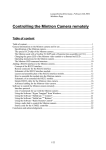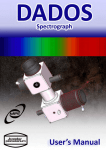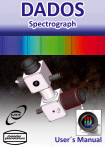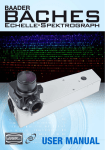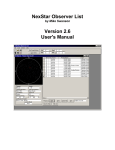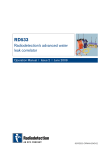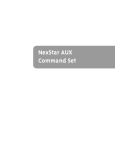Download Tips, hints and pending problems for Celestron Nexstar 114GT
Transcript
Langenbrettach, August 14th 2001 Matthias Bopp Tips, hints and pending problems for Celestron Nexstar 114GT (original handcontroller before the update): 1.) The optical tube was inserted backwards, but it is easily removed by unloosening the "tube holder" connected to the arm. Remove and replace tube in the position as seen on your manual. If the tube is inserted correctly and levelled horizontally you should be able to read the labels "NexStar" both, on the tube and the little round one on the tube holder correctly. None of them must be upside down ! 2.) The arm's tube holder clamp needs to be turned a 180 degrees as well as it was upside down. Again look on your manual and you will see the brand name label right side up as mine was upside down. Both of these problems were making the telescope slew down to the ground when Goto planet Jupiter was selected and other preset space items to anywhere but to the object. In other words: Install the tube with the mirror end farthest away from the tripod, and the hinge on the OTA clamp should be at the bottom. 3.) Another overlooked problem may be you are trying to enter military time and this model is not programmed for that, so just enter as usual and enter pm or am plus the other parameters. 4.) The battery connector is not very high quality. I had to replace the connector the second day. I do now use a chinch connector (RCA connector) because the jack suits exactly in the hole of the NexStar casing where the original jack had been. So I did not have to alter the Telescope (respectively its casing). In case I have to return it within the warranty time I can change it back in 5 minutes. 5.) An ac/dc adapter or a rechargeable battery pack is more efficient than batteries. I never used the battery pack but do use a 12V, 7Ah rechargeable sealed lead-acid battery. This type of battery does not need trickle charging and do not have a memory effect like NiCd accumulators. So you can just fix the supply voltage of the charger to 13.8V (at room temperature) and you can leave it connected to the battery as long as you like without harming the accumulator by overcharging. Please do not make the supply wires longer than needed and use thicker wires. 6.) The time zone offset from GMT for Germany is not "01" as indicated in the German manual but "23" because the time zones are counted the other way around. 7.) Storing and recalling an observers position (lat, long) in the memory does not work on (my) NexStar114GT. The alignment stars are far off. It is much better to use one of the predefined cities, even if it is more than 100km away. For instance I am using Frankfurt/Germany (which is approx. 120km away !). The little NexStars have a bug which prevents stored long/lat from working in the Eastern hemisphere. 8.) The initial alignment is crucial. It is essential to align the whole tripod horizontally and the tube north. See enclosed explanations from a friend: The issue is that the NexStar needs the lat and long data to find the alignment stars for you to use. If the base is not level, then the "virtual" location of the scope is -different- than the location described by the lat and long. To illustrate this, take a globe, put your hand on your location with it perpendicular to the globe radius at your location. This is the condition the NexStar wants because it is the location corresponding to the lat and long that you entered. Now, tilt your hand slightly. Move around the globe until the globe radius vector is perpendicular to your hand (don’t move the globe). This is the "virtual" location. The NexStar depends on the AZ and ALT axis (RA and DEC if you are polar aligned) being perpendicular. There is no hard index in the system. So, you must tell it that piece of data each time you power up. This means you must put the OTA perpendicular to the arm at each power up (NOT level). The encoder accuracy is 20 arc sec so you should strive for that accuracy. 9.) It should be essential during alignment to take care of the backlash effect. However the backlash values are not stored in memory as stated in the manual so they have to be programmed every time you power on the telescope. Please program the 2 values first and then do the auto alignment ! For my telescope the value 25 is optimum for AZ and the value 10 optimum for ALT. I first bypass auto-alignment and enter the backlash values. Then I try to track a Star and the telescope will say "No Alignment". Pressing 3 times "Undo" will get me back to the main menu saying "NexStar ready" and asking for auto-alignment. I centre the object in the viewfinder also during auto-alignment and 3rd star alignment always by moving from left to right and bottom to top. 10.) The encoder constants of the 114GT and 4GT for AZ and ALT are 1059334. The encoder constants of the 60GT and 80GT for AZ and ALT are 0726559. Some NexStars have been shipped with the wrong encoder constants so please check it. Otherwise you will not achieve proper alignment/Goto/tracking. Please note selecting the model from the build in list does not work, instead you have to select "Custom" and enter the constants given above. You must do this even if the correct model is shown in the display. 11.) After a reasonable good initial alignment as stated in 11.) and 3 hours time the alignment was completely gone. Executing e.g. the command Goto AZ/ALT and giving the values 0/0 would tilt the telescope at least -10° below the horizon. 12.) The GT version of the small NexStars cannot be controlled by the GuideStar software running on a PC. Only the HC version does work. The GT version can be controlled by e.g. the Planetarium program running on a Palm. Celestron works on fixing the GT controller. 13.) The enclosed Software GuideStar 2.1 cannot even be installed on a PC with German Windows. I tried Windows 95 as well as Windows 2000 without success. The fix is: simply create a directory c:\program files and copy the original guide star folder in this directory. Actually this is also necessary on US PCs because Guidestar expects to be installed on C:\program files ! 14.) I had some problems when using the Guidestar software together with my new HC hand-controller for my NexStar114GT: When comparing the calculated RA/DEC values with other programs I found quite some differences ... finally I found the root cause: You must not set the Windows PC's country settings to German ! When changing to English(USA) it seems to work fine. The difference can be seen in the RA/DEC values for a star in the windows "information" and "change information". In the latter the values are consistent with the values shown by "the sky" and "planetarium". However if the country settings are set to German these values are wrong converted to the used RA/DEC values in the window "information". Sometimes my NexStar114GT (controlled by the program GuideStar 2.1) starts slewing completely crazy until the tube hits the base (= mechanical limit). Here are my settings: PC running Windows 2000 with Country-code English(USA) Location Frankfurt/Germany Date 02/28/2001 Time 11:37pm Time-Zone 23 Daylight savings off Altitude limits 0 and 65 Tracking on Backlash settings AZM+=100, AZM-=100, ALT+=50, ALT-=50 After a dummy alignment indoor (accepting the centred 2 stars in auto alignment) I did a Goto to Sirius. It should have been at an altitude of approximately 12°. Instead of going there the telescope slews towards zenith until it hits the mechanical limit (tube hits the base). I did power off the telescope completely and started from the very beginning: same result ;-( 15.) The RS232 cable for connecting the telescope to the PC is the same for the NexStars 4/5/8/60/80/114. A very comprehensive description can be found at Mike Swanson’s NexStar Resource Homepage at http://www.nexstarsite.com/PCControl.htm . 16.) Maybe there is a similar effect of faulty memory for the location as in the NexStar 5 or 8: there only the locations 0-4-8 or 1-5-9 do save the values correct. The reason is an overflow of memory i.e. saved data would spill in adjacent memory locations. It is not yet verified that this is also the case with the NexStar114GT. 17.) When using the Goto function for a planet only the ALT value can be checked during tracking. The AZM value is not available when toggling through the information menu. 18.) The NexStar controller does sometimes lock up: 13.01.01 at low outside temperature (-5°C) after approx 15min. during Goto command to new star (trying to abandon old Goto command). Display shows only "1"s in both lines. (See next item 18.) 10.02.01 outside temperature approx. +5°C. After 2 hours of very good Goto performance (Saturn, Jupiter and Orion nebula in the FOV of a 15mm EP) it locks. Display shows only the characters "b" in both lines. 19.) At lower temperatures the display reacts very slow. Celestron recommends to use a small heater (chemical or electrical) attached to the hand controller when using it below the freezing point. 20.) How to do a daytime alignment e.g. for the sun: First do an Auto Align,. You need the date and time for "finding" the sun. Just align the telescope north and level it horizontally. Then just accept where the scope goes for the alignment stars and then do a Goto on the sun. You will most likely not hit the sun but should be reasonably close. You can then either look at the shadow of your scope on the ground and move the scope east/west the up/down to minimize the shadow. You can also use the Starfinder (after adding a solar filter to it). Just move the whole tripod, not the move it by the motors. Set your tracking rate to Solar. 21.) When going through the auto-alignment procedure please make sure that you start to centre the alignment stars with the Starfinder, next with your lowest power EP and then move up with the power until you have maximum power. If you do have a Barlow use it too. The move to the next alignment star and repeat the procedure. This will improve the Goto and Tracking performance significantly. 22.) I recently built a solar filter from a din A4 sized (200mmx290mm) Astro-Solar film from BaaderPlanetarium (www.baader-planetarium.de). I used the D=5 version which is proposed for visual observations. There is another one with D=3 for photographical applications but D=3 can harm the eyes so you must not use it without additional filters. It was simple to build the solar filter according to the enclosed construction tips. So my little daughter and I enjoyed both: building the homebrew filter and exploring first time some sunspots. 23.) After a Goto the direction buttons will work very but a very low speed. First you should leave the menu e.g. showing the position of the tracked object. Just press "Undo" so many times until you get in the main menu. The telescope should show "Ready". Please note that as long as tracking is activated the effective speed is set very low ( even if you check the rate and it shows 9). You can move quickly by pressing the direction button and its opposite button simultaneously, e.g. if you want to move quickly left, press the "left" button and then additionally the "right" button. Once you set the tracking mode to "off" the effective speed is as set in the menu "Rate". 24.) If you want to centre the alignment stars, Mike Swanson has been using the following trick: When you are performing the final centring of each star in your high-power eyepiece, defocus the star, it will turn into a circle that is much easier to centre than a single point of light. Plus, it doesn't cost anything and it's one less thing to have in your accessory case :-) 25.) Please have a look at the following sites, they do provide more up to date information. Sorry, the list may not be up-to-date and is certainly not complete. http://www.nexstarsite.com http://www.wigloo.com/webu/lea/80gt.html http://www.grcooperjr.com/disc2_frm.htm http://home.att.net/~nexstar/index.html http://www.koessel.com/nexstar/ http://209.20.244.173/dons Kind regards Matthias Email: [email protected] Homepage: http://www.dd1us.de



